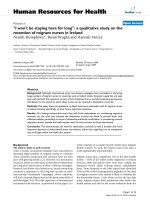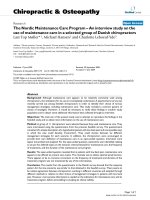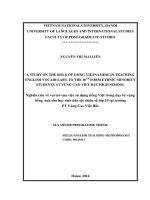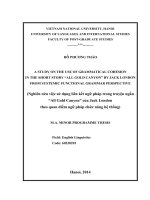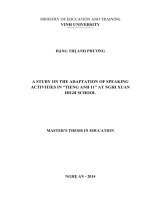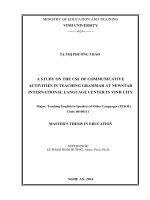Study on the methods of identification of bacillus thuringiensis in biological pesticide (khóa luận tốt nghiệp)
Bạn đang xem bản rút gọn của tài liệu. Xem và tải ngay bản đầy đủ của tài liệu tại đây (1.8 MB, 63 trang )
VIETNAM NATIONAL UNIVERSITY OF AGRICULTURE
FACULTY OF BIOTECHNOLOGY
------- -------
GRADUATION THESIS
TITLE:
STUDY ON THE METHODS OF IDENTIFICATION OF
BACILLUS THURINGIENSIS IN BIOLOGICAL
PESTICIDE
HANOI – 2022
VIETNAM NATIONAL UNIVERSITY OF AGRICULTURE
FACULTY OF BIOTECHNOLOGY
------- -------
GRADUATION THESIS
TITLE:
STUDY ON THE METHODS OF IDENTIFICATION OF
BACILLUS THURINGIENSIS IN BIOLOGICAL
PESTICIDE
Student
: Pham Van Tuan
Class
: K62CNSHE
Student’s Code
: 620553
Supervisor
: Dr. Ninh Thi Thao
HANOI – 2022
COMMITMENT
I assure that the entire study procedure was carried out by myself under the
scientific supervision of Dr. Ninh Thi Thao.
I assure that all research contents, conclusions, and information in my
graduation thesis are entirely honest and unpublished.
Hanoi, May 15th 2022
Sincerely,
Pham Van Tuan
i
ACKNOWLEDGEMENTS
During the 6 months of doing my graduation thesis at the Department of
Plant Biotechnology - Faculty of Biotechnology - Vietnam National University
of Agriculture, I had the opportunity to consolidate and practice my knowledge
and study skills to be able to complete the thesis well. mine. In addition to my
own efforts, I have received a lot of enthusiastic help from the teachers as well
as people around.
I am highly grateful to supervisor Dr. Ninh Thi Thao, for giving me much
advice and spared no effort in helping me do this work.
Many people have written many words in praise of her scientific attitude,
untiring work but, I think I have no words for this renowned scientist as feelings
are deep but unfortunately words are too shallow, that cannot fathom my
feelings of respect for her.
I believe that whatever I learnt from his personality will guide me in every
field of life.
I would like to express my sincere thanks to all the teachers who have
enthusiastically taught in the biotechnology department of the Vietnam National
University of Agriculture.
I am also grateful for the care and support of my family and friends.
That is a great source of encouragement for me to pursue and complete this
Graduation essay.
I am thankful to all those who are
Hanoi, May 15th 2022
Sincerely,
Pham Van Tuan
ii
INDEX
COMMITMENT ........................................................................................................ i
ACKNOWLEDGEMENTS ...................................................................................... ii
INDEX .................................................................................................................... iii
LIST OF ABBREVIATIONS ................................................................................... v
LIST OF TABLES ................................................................................................... vi
LIST OF FIGURES ................................................................................................. vii
ABSTRACT ........................................................................................................... viii
PART I. INTRODUCTION ...................................................................................... 1
1.1.
Preface ......................................................................................................... 1
1.2.
Objectives and requirements ....................................................................... 2
1.2.1.
Objectives.................................................................................................... 2
1.2.2.
Requirements .............................................................................................. 2
PART II. LITERATURE OVERVIEW .................................................................... 3
2.1.
Introduction of Bacillus thuringiensis species ............................................ 3
2.1.1.
History of Bacillus thuringiensis Discovery and Their Classification ....... 3
2.1.2.
Morphological characteristics ..................................................................... 5
2.1.3.
Biological toxin and toxicity mechanisms .................................................. 7
2.2.
Application of BACILLUS THURINGIENSIS biological products ............. 15
2.2.1.
In the world ............................................................................................... 15
2.2.2.
In Vietnam................................................................................................. 17
2.3.
Methods currently used for identification of bacteria ................................ 20
2.4.
Introduction of biological product “Delfin®WG” .................................... 22
PART III. MATERIALS AND METHODS........................................................... 25
3.1.
Materials.................................................................................................... 25
3.2.
Time and place of the study ...................................................................... 25
3.3.
Research contents and methods ................................................................ 25
iii
3.3.1.
Isolation of Bacillus thuringiensis from the sample ................................. 25
3.3.2.
Identify Bt based on morphological and biochemical characteristics ...... 26
3.3.3.
Determining effective techniques for DNA extraction from Bt ............... 27
3.4.
Media and chemicals ................................................................................. 30
3.5.
Data analysis ............................................................................................. 31
PART IV. RESULTS AND DISCUSSION ............................................................ 32
4.1.
Isolation of Bacillus thuringiensis from “Delfin®WG” .............................. 32
4.2.
Identification Bt isolates based on the morphological characteristics ........ 32
4.2.1.
Colonical morphology............................................................................... 33
4.2.2.
Cell morphology ....................................................................................... 34
4.2.3.
Spore and crystal morphology .................................................................. 35
4.3.
Identification Bt isolates based on the biochemical characteristics .......... 37
4.3.1.
Lecithinase test .......................................................................................... 37
4.3.3.
Fermentation test ....................................................................................... 39
4.4.
Identification Bt at molecular level ........................................................... 43
4.4.1.
Quantification of Bt bacterial CFU in “Delfin®WG” .............................. 45
PART V. CONCLUSION AND SUGGESTION ................................................... 47
5.1.
Conclusion ................................................................................................ 47
5.2.
Suggestion ................................................................................................. 47
REFERENCES ........................................................................................................ 49
iv
LIST OF ABBREVIATIONS
ABBREVIATION
EXPLANATION
Bt
Bacillus thuringiensis
CFU
Colony forming unit
CTAB
Cetyl trimethylammonium bromide
DNA
Deoxyribonucleic Acid
LB
Luria Bertani broth
MYP
Mannitol Egg Yolk Polymyxin
PCR
Polymerase chain reaction
subsp.
Subspecies
var.
variety
Βme
Beta-Mercaptoethanol
v
LIST OF TABLES
Table 3.1.
PCR primers used in the study............................................................ 29
Table 4.1.
Morphology characterizations of Bt strains ........................................ 36
Table 4.2.
Results of biochemical testing ............................................................ 40
Table 4.3.
Purity and yield of genomic DNA extracted from Bt ......................... 41
vi
LIST OF FIGURES
Figure 2.1. Colonies of Bacillus thuringiensis on Nutrient agar (NA)
medium (Majdoub N, 2016) ......................................................... 5
Figure 2.2. Colony morphology of Bt on NA medium ................................... 5
Figure 2.3. Morphology of insecticidal crystals produced by the IS5056
isolate of B. thuringiensis subsp. thuringiensis ............................ 6
Figure 2.4. Mode of action of Bacillus thuringiensis cry toxins................... 13
Figure 2.5. Insecticidal activity of Cry and Cyt δ-endotoxins against the
orders Diptera, Coleoptera, Lepidoptera, Hemiptera, and
Hymenoptera ............................................................................... 14
Figure 2.6. Product packaging images Delfin®WG ..................................... 22
Figure 3.1. Biological control product “Delfin®WG” .................................. 25
Figure 4.1. Colony image of microbial strains in Delfin WG preparation ... 32
Figure 4.2. Colony morphology of DT isolate on T3 medium ..................... 33
Figure 4.3. Gram staining of the isolates at 1000X magnification.
Vegetative form of Bacillus (rod shaped and thin), grampositive (violet) ........................................................................... 34
Figure 4.4. Coomassie staining of the isolates at 100X magnification. ........ 35
Figure 4.5. Lecithinase reaction results. ........................................................ 37
Figure 4.6. Catalase reaction results.............................................................. 38
Figure 4.7. Fermentation reaction results. ..................................................... 39
Figure 4.8. Total DNA extraction using three different extraction
techniques on n agarose gel electrophoresis. .............................. 42
Figure 4.9. Amplification of PCR results of GroEL, GyrB, XRE and
Cry2 from Bt strains on agarose gel electrophoresis. ................. 44
vii
ABSTRACT
Bacillus thuringiensis (Bt) is one of the most widely utilized biological
agents to manage insect pests because it produces a variety of toxins with strong
and targeted insecticidal activity. One of the products containing Bacillus
thuringiensis (Bt), "DELFIN® WG" probiotic, is anticipated to be able to
supplement or replace chemical medications due to its benefits, including
excellent specificity for target insects, safety, and therefore most especially
environmental friendliness.
To identify and quantify Bt in the biological insecticide "DELFIN® WG,"
we analyzed the morphological, biochemical, and molecular characteristics of
putative isolate and compared with reference strain. The results showed that the
putative Bt isolate from "DELFIN® WG" shared traits with reference Bt strain
4T1 in terms of lethicinase, sucrose, and catalase positivity as well as cell,
colony spore, and protein crystal properties.
PCR was used to determine whether the putative isolates contained the four
specific genes of Bt including XRE (transcriptional regulator), GroEL
(chaperonin protein), GyrB (topoisomerase enzyme), and Cry2 (crystal protein).
The findings demonstrated that the putative isolate had the distinct band
corresponding to the target genes, proving that they are Bt. As a result, we
concluded that by morphological, biochemical, and molecular analyses can be
utilized in combination to identify Bacillus thuringiensis in "DELFIN® WG"
specifically, as well as in other Bt-contained products generally.
viii
PART I. INTRODUCTION
1.1. PREFACE
The use of chemical crop protection measures is a key component of
integrated pest and disease management of crops. Along with the benefits, this
category of compounds also showed a lot of drawbacks. Chemical pesticides
cause the ecosystem to become out of balance by killing beneficial insects as
well as reducing the effectiveness of target insects by causing resistance.
Additionally, using chemical pesticides over an extended period of time causes
poisons to build up in the environment, harming both human health and the
environment. In addition, the use of insecticide use in densely populated
metropolitan areas will have an impact on public health (Dang Bao Ha, 2015).
Finding a bio-friendly substitute is thus urgently needed. The creation of biopesticides that are efficient, biodegradable, and ecologically benign is an
appropriate course to take. The practice of gradually replacing chemical
pesticides with biological ones is becoming more popular. The use of
biopesticides in agriculture and public health has many advantages, including
the absence of residue on agricultural products, which worries customers,
especially for produce like vegetables and fruit (Dang Bao Ha, 2015).
From insects, plants, soil, and water, more than 90 species of specialist
insecticidal bacteria have been discovered (Vos et al., 2009). However, only a
few number of species—such as the bacterium Bacillus thuringiensis—have
received much study and attention to yet (Bt). Because of their benefits,
including their great specificity for target insects, safety, and especially
environmental friendliness, biological insecticides from Bt are believed to be
able to replace or enhance chemical medications. A gram-positive, aerobic soil
bacterium called Bacillus thuringiensis has cry genes for spore manufacturing
and toxin crystal protein, which may be used to kill a variety of squamous,
1
beetle, and bipedal insect species (Das et al., 2021). They offer a broad spectrum
of actions that can oppose pathogenic fungus while being safe for people and
plants. However, Bacillus also contributes to the process of turning complex
organic compounds into simple organic compounds that plants can utilize
readily, improving soil, and regulating and eradicating some hazardous microbes
plant illnesses as a result of their unique biological roles (Le Duc Manh et al.,
2003). The bacteria of the genus Bacillus are used in agriculture to improve soil,
boost production, combat certain fungi and bacteria in the root zone of plants,
enrich the soil microbiota, and restore soil fertility.
The development of a technique to identify and assess Bacillus
thuringiensis in samples of microbial products under Vietnamese conditions
requires research and has both scientific and practical value. Vietnam currently
produces a large number of Bt pesticide products, however there are still few
ways to identify and measure them. Additionally, the current baseline standards
in Vietnam cannot subjectively or quantitatively measure Bt in pesticides. This
study intends to establish a method to detect and quantify Bacillus thuringiensis
in biological insecticides containing Bt in Vietnam. It is based on that practice
and current research trends in the globe and the nation.
1.2. OBJECTIVES AND REQUIREMENTS
1.2.1. Objectives
Identification and characterization of Bacillus thuringiensis in the biological
product “DELFIN® WG”.
1.2.2. Requirements
- Isolate putative Bacillus thuringiensis from the sample
- Characterize putative Bt isolates based on morphological and biochemical
characteristics.
- Identify the appropriate method for DNA extraction from Bt.
- Characterize putative Bt isolates by PCR amplification of specific genes of Bt.
2
PART II. LITERATURE OVERVIEW
2.1. INTRODUCTION OF BACILLUS THURINGIENSIS SPECIES
Bacillus thuringiensis (Bt) is a soil bacterium that forms spores during the
stationary phase of its growth cycle. The crystals found in the spores are mostly
made up of one or more Cry and/or Cyt proteins, commonly known as dendotoxins, which have strong and targeted insecticidal activity. Different Bt
strains create unique poisons, each of which affects a specific subset of insects.
Since the 1920s, pesticides containing the Bt toxin have been used extensively in
organic farming. Additionally, Bt is a source of the genes that are used to
genetically modify a variety of food crops so that they create poisons to fend
against different insect pests. Lepidoptera (butterflies, moths, and bugs), Diptera
(flies), and Coleoptera (beetles) are among the insect species for which the
poison can be fatal; however, several strains of Bt are available for use in more
targeted pest control (Mullaney et al., 2017).
2.1.1. History of Bacillus thuringiensis Discovery and Their Classification
The insecticidal properties of Bt were recognized many years before the
bacteria were identified, with some records suggesting that Bt spores may have
been used in ancient Egypt. In modern times, this bacterium was isolated by
Japanese biologist Shigetane Ishiwatari in 1901 while investigating silkworm
wilt and he named it Bacillus sotto. Ten years later, Ernst Berliner isolated the
same bacteria from a diseased Mediterranean butterfly (Ephestia kuehniella) in
the German province of Thuringia, and it was named Bacillus thuringiensis
(Siegel, 2000). The defining feature of Bt is its ability to produce protein crystals
during sporulation. Bt is a member of the Bacillus cereus group of sporeforming gram-positive soil bacteria, which sometimes lose their ability to form
crystals and are subsequently indistinguishable from B. cereus itself. Similarly,
B. cereus can be transformed into Bt, and research into the transformation
3
mechanism has led to the discovery that crystal formation is caused by genes
carried on the plasmid. The genes, which code for the Cry/Cyt proteins, become
active during spore formation because they are controlled by a specialized RNA
polymerase that is also specifically synthesized during spore formation. Up to
20% of the protein content of spores is represented by these Cry/Cyt toxins
(Aronson, 2002). The insecticidal properties of crystals were discovered when
dead pollen moths were found filled with spores and crystals. Direct contact
between spores / crystals and healthy caterpillars has no effect, but when the
spores and crystals coat the leaves, the caterpillars stop feeding and die. After
realizing the potential of Bt as an insecticide, Mattes (1927) isolated the Bt strain
discovered by Ernst and subsequent field tests against the European stem borer
(Ostrinia nubilalis) showed promising results (Husz, 1930). This work
eventually led to the development of Sporeine, a commercial Bt insecticide, first
used in 1938.
The species Bacillus thuringiensis classified as follows:
According to Bergey's taxonomy, the species Bacillus thuringiensis
classified as follows:
Gender: Bacteria;
Industry: Firmicutes;
Grade: Bacilli;
Set: Bacillales;
Family: Bacillaceae;
Genus: Bacillus.
Species: Bacillus thuringiensis
There are several dozen recognized subspecies of B. thuringiensis.
Subspecies commonly used as insecticides include B. thuringiensis subspecies
4
kurstaki (Btk), subspecies israelensis (Bti) and subspecies aizawa. Some Bti
lineages are clonal.
2.1.2. Morphological characteristics
Bt is a Gram-positive, rod-shaped aerobic bacterium with vegetative cells
1.0-1.2 μm wide and 3.0-5.0 μm long, usually motile by peritoneal flagella few.
The flagellates can bind to insect cells and play an important role in virulence.
Colony
morphology
can
help
to
distinguish Bt
colonies
from
other Bacillus species. The organism forms white, rough colonies, which spread
out and can expand over the plate very quickly.
Figure 2.1. Colonies of Bacillus thuringiensis on Nutrient agar (NA)
medium (Majdoub N, 2016)
Figure 2.2. Colony morphology of Bt on NA medium
5
The colonies are 5-6 mm in size, slightly raised, entire with smooth-looking
center and encircled by granular side. (a) Fried-egg appearance of the colony
viewed from top of the Petri plate; (b) Colony morphology viewed from reverse
surface of the Petri plate. Bar = 2 mm (Pui Fun Chai, 2015).
In vegetative cells, spores and crystals are often adjacent to each other,
when the cell dissolves, the spores and crystals escape together (Truong Phuc
Hung, 2010).
Figure 2.3. Morphology of insecticidal crystals produced by the IS5056
isolate of B. thuringiensis subsp. thuringiensis
(A) Transmission electron micrograph of sporulated cells. (B) Scanning
electron micrograph of purified crystals. (C) Higher magnification (×3.6) of
crystals in the area circled in panel B. sp, spore; c, crystal. Notes: (a) vegetative
cells, (b) spores, and (c) the crystalline toxin (Izabela Swiecicka, 2008)
6
A single Bt cell forms only one endospore, which is oval or cylindrical in
shape. Bt strains have elliptical, elliptical, sporangia located below the crystal.
Morphology, size, and number of living organisms may vary among Bt strains
(Mukhija et al., 2018). Spores are resistant to heat and acids. Depending on the
species, spores can be located in the middle or the end (Luong Duc Pham,
2011). Bt is distinguished from other bacilli by the production of parasporal
crystalline protein (delta-endotoxin) (Yamamoto et al., 1993). The crystal is a
protein approximately 0.6 x 0.02 μm in size, can account for 25% of the dry
weight of the cell, and has a variety of shapes. However, there are four distinct
crystal morphologies: typical bipyramidal crystals, associated with Cry1
proteins, cuboidal inclusions associated with Cry2 proteins, and often associated
with dimorphic crystals pyramidal, amorphous and mixed crystals involving the
Cry and Cyt proteins, and flat and square crystals, bound to the Cry3 Protein
protein (Meza et al., 1996). Spherical crystal morphology and irregular pointed
shape can also be observed in Bt strains (Babita et al., 2018).
Bacillus thurigiensiss grows best at 28 - 30°C, pH 6.8 - 7.2. During growth,
bacteria convert sugary components from the environment into acetic, lactic and
pyruvic acids…Then these substances are used by the body. Therefore, the pH
of the medium increases at first (logarithmic phase) and then decreases.
The ability of Bacillus thurigiensis to produce spores depends on many
factors, especially nutritional factors. Bacteria that are able to nitrify, cannot
ferment arabinoza, xylose and mannitol, grow weakly in an anaerobic
environment.
2.1.3. Biological toxin and toxicity mechanisms
The formation of spores from one or more protein-based crystals next to
the spore during sporulation is the primary distinction between Bacillus
7
thuringiensis and other closely related bacilli. Some of these parasporal crystals,
sometimes referred to as -endotoxins (Cry and Cyt), are pathogenic to the larvae
of many insect species, primarily Lepidoptera, Diptera, and Coleoptera, as well
as other phylum species in some situations. Bacteria can secure their survival by
generating parasporal crystals during sporulation because a dead insect can give
enough nutrients for the spores to germinate. Bt strains produce edge crystal
inclusions of the crystalline (Cry) and cytolytic (Cyt) toxins (sometimes referred
to as -endotoxins) at the start of sporulation and during the stationary growth
phase. Additionally, during the vegetative stage of development, Bt isolates can
also produce additional insecticidal proteins; these are subsequently secreted
into the culture medium, vegetative insecticidal proteins (Vip), and insecticidal
proteins (Sip). B. thuringiensis is capable of producing 4 types of toxins during
their growth:
Exotoxins (alpha - exotoxins) also known as phospholipase - C.
Beta-exotoxins are also known as heat-stable exotoxins.
Endotoxin (gama - endotoxin) is also known as toxic crystal.
Water soluble toxins.
Of the four toxins of B. thuringiensis, the most attention is paid to the
water-soluble and crystalline toxins.
Poisonous groups of B. thuringiensis
The bacterium B. thuringiensis causes disease in insects through the
digestive tract. Spore germination leads to the reproduction of bacteria in the
host body, causing the insect to die, but the main factor that causes the insect to
die quickly is the toxin produced by the bacteria. Different strains of the species
B. thuringiensis produce two main toxins, namely crystal poisons (Cry - Crystal)
encoded by different cry genes (this is also one of the markers used to
8
distinguish them group B. thuringiensis) and cytolytic toxins (Cyt - Cytolytic)
have separate and combined effects with Cry to increase the effect of toxic
crystals. Cyt toxins include exotoxins (secretory products of bacteria).
The alpha exotoxin is an enzyme phospholipase C or leucitinase C that is
secreted before the formation of toxic spores and crystals, causing tissue
breakdown in the affected insect's body, heat-labile, molecular weight short.
Beta exotoxins are the best-studied B. thuringiensis exotoxins. This toxin is
heat stable and is produced before toxic crystals form. Exotoxins have a
structure similar to ATP, have a competitive effect with ATP, and inhibit the
activity of RNA - polymerase. Together with toxic crystals, this exotoxin
penetrates the plasma of insects, reaches the organs, increases the toxicity of
bacteria when entering the insect's body. The effect of the toxin is clearly shown
on the larvae of the insect affected, preventing the molting process, or causing
an anomaly in development. The effect of this toxin also depends on the dose
used and the mode of toxicity, causing toxicity through injection to be more
effective than through the gastrointestinal tract.
Gamma exotoxin is a type of phospholipase that acts on phospholipids,
causing tissue damage. Exotoxins are heat stable (at 120ºC after 15 minutes,
they still retain their activity). This toxin has a molecular weight of 707 - 850
Daltons. Exotoxins contain aderrin, phosphate, ribose, glucose and allomusic
acid.
Compared with the above three groups of exotoxins, toxic crystals (or Cry
toxic crystals) were first discovered by scientist E. Berliner in 1915, then in
1927, scientist O. Mattes found one type of crystals that are produced in B.
thuringiensis when B. thuringiensis begins to form spores.
9
Toxic crystals are produced in much larger quantities and have the primary
effect of being toxic to insects. It was not until 1955 that this crystal was found
to be of a protein nature and was associated with the toxicity of B. thuringiensis.
In addition to protein components, toxic crystals also contain many other
elements such as: Ca, Mg, Fe, Si, Zn or Al... Toxic crystals are created at the
beginning of the spore membrane formation process. When crystallized into
crystals of various shapes, mainly rhombic. Crystals are insoluble in water, or
organic substances Chloroform, Acetol, ether, but can dissolve in alkaline
solutions. Crystals are stable in solutions with a wide pH range (4-12), can be
denatured in trichloroacetic acid, mercuric chloride. Although sensitive to high
temperatures, it has certain heat resistance (at 65ºC can be kept for 1 hour, 80ºC
can be kept for 20 minutes).
Poison crystals are quite long and wide (about 1 µm long and about 0.5 µm
wide). They constitute about 30% of the total cell mass and exhibit virulence of
B. thuringiensis.
Toxic crystals often kill the larvae. In the toxic crystal composition, there
are two types of amino acids, glutamic acid and asparaginic acid are the most
abundant.
The toxic crystal is considered a prototoxin. It becomes a true toxin only
when present in the intestines of certain insects. Then will form toxic particles
with molecular weight of about 5000. Toxic crystals are heat-stable, often
causing damage to the digestive tract of pests. When the intestinal tract is
paralyzed by toxic crystals, the epithelial cells of the intestine are changed.
Toxic crystals of B. thuringiensis only toxic to intestinal pests, but to humans
and animals, toxic crystals are completely harmless. Several studies have shown
10
that in mammals, pepsin in the gastrointestinal tract converts the toxic state of
the toxic crystal to the non-toxic state.
More than 50 genes encoding toxic crystal proteins have been sequenced,
allowing these toxins to be classified into 15 groups based on sequence
similarity.
Insecticidal toxins of B. thuringiensis strains have been divided into four
main groups: CryI, CryII, CryIII and CryIV based on the insecticide activity of
the toxin. The CryI proteins are toxic to squamous insects, CryII is toxic to both
squamous and bipedal insects, CryIII is toxic to beetles, and CryIV is toxic to
bivalves. These proteins are further divided into subclasses (A, B, C, ...) and
subclasses (a, b, c, ...) according to the DNA sequence of the toxin.
Mechanism of toxicity of Bacillus thuringiensis
Toxic crystals along with spores enter the worm's body through the
digestive tract when the caterpillar eats leaves containing B. thuringiensis.
Under normal conditions, this insoluble toxic crystal is not yet the active form.
The prototoxic form into the active (60-66kDa) toxin form. This toxin binds to
intestinal epithelial cells, penetrates the membrane to form a hole in the
membrane, disrupts the intracellular ion balance of epithelial cells and causes
them to decompose, the worm stops eating and starves to death. Intestinal pH is
reduced to equal plasma endothelial pH. This low pH allows the spores to
germinate, invade the host, and ultimately cause death.
Recent studies on endotoxin structure show that this protein has three
functional regions:
Region I is a bundle of 7 helices. Some or all of the chains can insert into
the intestinal cell membrane, creating holes through which ions can pass freely.
11
Region II contains three non-parallel bands similar to the intestinal
epithelial antigen-binding region.
Region III is responsible for protecting the activated toxin from being
degraded by intestinal proteases.
With such a complex structure, the endotoxin binds specifically to
receptors on the intestinal epithelial cell membranes of worms, causing the chain
effect outlined above. This makes the specificity very high in the effect of Bt on
pests. Therefore, the spectrum of action of B. thuringiensis is relatively narrow,
depending on the type of toxic crystal that B. thuringiensis strains are effective
against the worms of the main insect group Lepidoptera.
B. thuringiensis bacteria, after entering the intestines of insects (insects that
eat vegetables with B. thuringiensis bacteria), toxic crystals will be released.
When toxic crystals enter the intestinal tract of insects, there are two factors that
create toxicity to insects:
Some insects produce proteases in the intestinal tract. These enzymes
convert the crystal's precursors to toxins.
Insect intestinal pH: The pH of the midgut and anterior intestine of insects
is in the alkaline pH region (> 8.9). When the pH is at this value the crystal
breaks.
The broken toxic crystal will form small fragments that attach to the intestinal
wall, then the intestinal wall is broken and leaves the epithelium unharmed. Due to
the breakdown of the intestinal wall, intestinal contractions stop.
When the intestine stops contracting, bacterial metabolites (and normal
intestinal metabolic products) are deposited somewhere in the intestine, causing
toxicity to the epithelium.
12
The epithelium is destroyed, cell by cell, and the intestine is perforated, and
toxic spores and crystals are transferred to the insect body cavity. Toxic crystals
penetrate into the blood and epithelial cells causing blood infection, insect death.
Besides, due to physiological changes in the intestine (intestinal wall is
destroyed), some normal bacteria in the intestine have become harmful bacteria
to insects. They move into the bloodstream and are also partly responsible for
the death of insects (they breed increasing the number of bacteria in the blood).
Figure 2.4. Mode of action of Bacillus thuringiensis cry toxins
2.1.4. Bioinsecticide activity of Bacillus thuringiensis crystal proteins
During the stationary phase of development, crystal proteins develop as
parasporal crystalline inclusions (Höfte et al., 1989; Schnepf et al., 1998). The endotoxins, which include the toxins Cry and Cyt, are the most well-known.
Researchers have discovered more than 700 Cry gene sequences in
plasmids that produce the crystal protein (Cry) (Höfte et al., 1989; Schnepf et
al., 1998; Frankenhuyzen et al., 2009). There is evidence that many Cry proteins
13
offer beneficial insecticidal characteristics for managing insect pests in
agriculture (Sanchis and Bourguet, 2008). But there have also been reports of
powerful cytocidal actions against vertebrates (Palma et al., 2014). There are 58
numbers of Cry proteins that are distinctive to the three main insect orders,
Coleoptera, Diptera, and Lepidoptera, according to a primary protein sequence
database search (Donovan et al., 2016; Sanchis et al., 2008; Naimov et al.,
2008). Different insect orders' sequences displayed varying lengths.
Figure 2.5. Insecticidal activity of Cry and Cyt δ-endotoxins against the
orders Diptera, Coleoptera, Lepidoptera, Hemiptera, and Hymenoptera
14
The Cry proteins currently make up the biggest class of insecticidal
proteins generated by Bacillus species. The three-domain and ETX MTX2
family proteins from Bt and Lysinibacillus sphaericus (previously known as
Bacillus sphaericus) are among the 73 different types of Cry proteins that have
been classified so far by the Bt Toxin Nomenclature Committee, with individual
toxins showing well-documented toxicity against lepidopterans, coleopterans,
hemi (Fig. 2.4).
In addition, some Cyt toxins are able to enhance the insecticidal activity of
other Bt proteins. The Cyt proteins are a smaller, distinct group of crystal
proteins with insecticidal activity against several dipteran larvae, particularly
mosquitoes and black flies. As of now, Cyt proteins have been divided into three
distinct families (Cyt1, Cyt2, and Cyt3; principal rank) by the Bt Toxin
Nomenclature Committee, with toxicity mostly against certain mosquitoes and
black flies.
2.2.
APPLICATION
OF
BACILLUS
THURINGIENSIS
BIOLOGICAL
PRODUCTS
2.2.1. IN THE WORLD
Insects had become resistant to synthetic pesticides by the 1980s, and
people were becoming more aware of the harm that chemical misuse was doing
to the environment. Government and corporate financing for alternatives,
including Bt research, has expanded as a result of growing economic interest in
alternative pest control technology. Foreign genetic material was effectively
produced in tobacco plants in 1984, proving the survival of transgenic plants
without any phenotypic loss (Horsch et al., 1984). Soon after, tobacco was given
the first Bt gene engineered for optimal plant expression (Vaeck et al., 1987).
The first commercial transgenic crops expressing the Bt gene were Bt cotton and
maize in 1996. More than 50 million hectares of Bt crops were planted in 23
15


